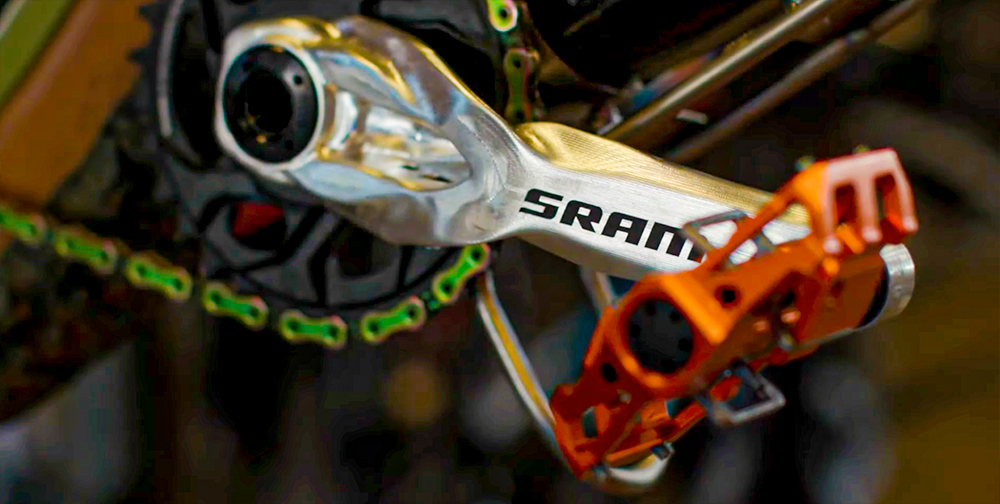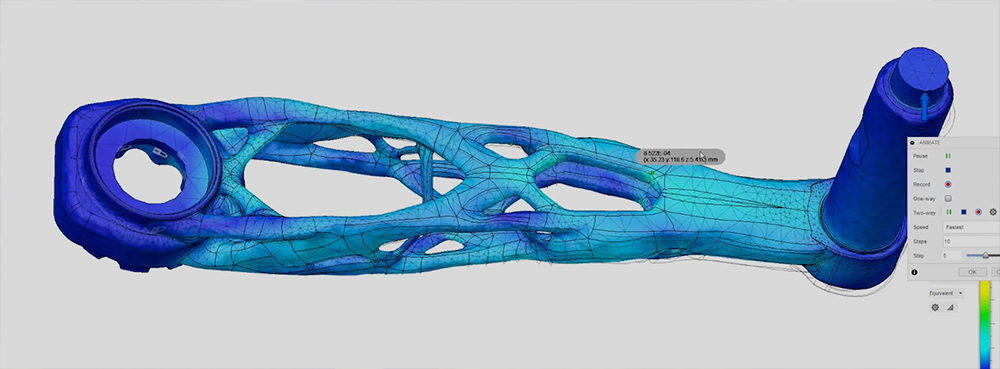Chicago-based bicycle component manufacturer SRAM teamed up with design software giant Autodesk to reimagine the humble bicycle crankarm, a part that’s been relatively unchanged since bicycles were first made.
Yet, it didn’t take the engineers at SRAM long to realize how artificial intelligence coupled with advanced manufacturing could revolutionize bicycle design one small part at a time.

“For SRAM the end-goal is to deliver cycling components that inspire the rider and make the bicycle faster,” says Will King, senior deign engineer at SRAM. “We started this project with Autodesk as a leader in generative design technology so that we can pair that with what we understand about bicycle design and look at optimizing our crankarm designs.”
The project began with SRAM’s standard crankarm and design software from Autodesk called Fusion360 that features generative design, a form of artificial intelligence that uses massive computing power and machine learning to accelerating the design and iteration process.

Generative design begins with the mechanical features a part must end up with and works backwards to develop options for a part’s optimal shape. The software “allows you to come up with dozens or hundreds of different designs that no human could ever think of and you’re getting those in a fraction of the time,” says Sean Manzanares, senior manger for business strategy and marketing at Autodesk.
Bicycle part design is usually a compromise between how a part must perform and how a part can be manufactured.
“Weight, stiffness, and cost are the three big players that we have to work around,” says Dhiraj Madura, SRAM’s global industrial design manager. “And obviously, within that, we have to work within manufacturing constraints. In a lot of ways, it limits us right off the bat.”
Generative design can ignore the limitations of metal casting for multi-part components or traditional machining, and instead create for the design freedom enabled by 3D printing, also known as additive manufacturing. Traditional methods have hit the wall, says Madura. “With generative design and additive manufacturing, we may be able to get rid of manufacturing processes so that we’re not looking at multiple parts. Maybe we can design it into one or two.”
Generatively designed parts often resemble shapes found in nature where material strength is placed only where necessary and excess mass is removed, like the structure of a leaf. The performance-optimized SRAM crankarm looks a lot like a plant structure. Instead of solid, its arms flow and join only where structurally necessary to transfer the rider’s force on the peddles to the drive chain.
These organic shapes are often difficult to machine with traditional methods, and can be cost prohibitive for prototype development where several functional iterations are required. SRAM prototypes were quickly 3D printed in titanium and field tested to see if the generative design algorithms got it right.
“From the digital idea to the physical element, additive manufacturing can help get you there quicker,” notes King. “It allows us to bring the idea into a physical space, evaluate it, test it, ride it, and go back and decide what elements of the design do we want to put into our production drivetrain.”

The end-result product was a crank that’s twice as strong and 20% lighter than those that use traditional manufacturing techniques.
The bicycle component industry is highly competitive and innovation is a key differentiator—whether it’s for performance, cost, weight, or speed to market. “Generative design is a tool that is allowing us to not only optimize performance perimeters for riders, but also shorten our development time to try new ideas, evaluate them, throw them out or give them more merit, and bring them to the prototype phase,” says King.
By experimenting with generative design and additive manufacturing for a new bike crankarm, SRAM realized a new source of research and development that will give their parts and business an edge.
SRAM’s generative design prototypes are not yet consumer-ready, but keep an eye out for futuristic parts sure to optimize your biking experience.
License: The text of "Autodesk AI Builds a Better Bicycle Crankarm" by All3DP Pro is licensed under a Creative Commons Attribution 4.0 International License.
